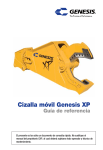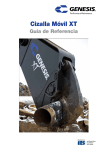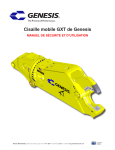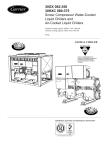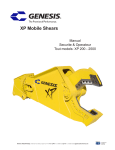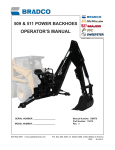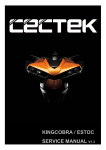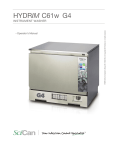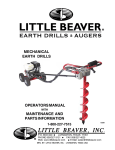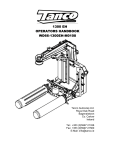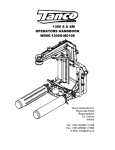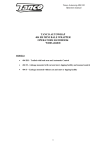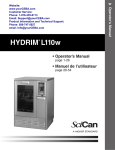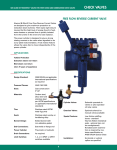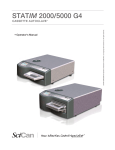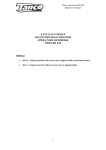Download Safety Manual - Genesis Attachments
Transcript
Versi Pro 07 (GVP 07) SAFETY & OPERATOR’S MANUAL CONTACT INFORMATION World Headquarters Genesis Attachments Europe/Africa/Middle East Genesis GmbH 1000 Genesis Drive Superior, WI 54880 USA Alpenstrasse 71 D-87700 Memmingen, Germany Toll Free: 888-SHEAR-IT (888-743-2748) Phone: +49 83 31 9 25 98 0 Fax: +49 83 31 9 25 98 80 genesis-europe.com Phone: 715.395.5252 Fax: 715.395.5255 E-mail: info@genesis-europe.com E-mail: info@genesisattachments.com Asia Pacific Representative Office 24 Upper Serangoon View #12-28 Singapore 534205 Phone: +65 9673 9730 E-mail: tchoo@genesisattachments.com Central & South America, The Caribbean Cra 13A #89-38 / Ofi 613 Bogota, Colombia Phone: (57-1) 610-8160 / 795-8747 E-mail: contact@themsagroup.com Brazil Rua José Alves dos Santos, 281 - Sala - 413 São José dos Campos / SP - Brazil Phone: +55 (12) 3905-3405 E-mail: metalamericas@metalamericas.com View and download all manuals at genesisattachments.com/manuals.asp 2 © 2015 Genesis Attachments, LLC Genesis Versi Pro 07 PREFACE To ensure years of safe, dependable service, only trained and authorized persons should operate and service your Genesis attachment. It is the responsibility of the operator to read, fully understand and follow all operational and safety-related instructions in this manual. Do not operate the attachment until you have read and fully understand these instructions. Always use good safety practices to protect yourself and those around you. REGISTRATION FORM The Warranty Registration Form must be filled out by the dealer or customer and returned to Genesis indicating the date the machine went into service. IMPORTANT This operator’s manual must remain with the attachment at all times. MANUAL REPLACEMENT Should this manual become damaged or lost, immediately contact any authorized Genesis dealer or the Genesis Service Department at 888-743-2748 or 715-395-5252 for a replacement. POSSIBLE VARIATIONS Genesis has made every effort to provide information as complete and accurate as possible for its attachments. However, because of owner requirements, equipment and control, variations may exist. In addition, due to Genesis’ policy of continually striving to improve its products, occasional discrepancies may exist between individual attachments and the descriptions and information contained herein. PUBLIC NOTICE Genesis reserves the right to make changes and improvements to its products at any time without public notice or obligation. Genesis also reserves the right to discontinue manufacturing any product at its discretion at any time. WARRANTY All work or repairs to be considered for warranty reimbursement must be pre-authorized by the Genesis Service Department. Any alterations, modifications or repairs performed before authorization by the Genesis Service Department will render all warranty reimbursement consideration null and void without exception. See page 48 for Warranty Claim Procedures. A lack of, or improperly performed, maintenance and procedures as set forth in this manual as well as operator abuse may render warranty consideration null and void. © 2015 Genesis Attachments, LLC Genesis Versi Pro 07 3 4 © 2015 Genesis Attachments, LLC Genesis Versi Pro 07 TABLE OF CONTENTS SAFETY STATEMENTS GENERAL SAFETY Read Manual Before Installation Read and Understand All Safety Statements Know Your Equipment Lower or Support Raised Equipment Do Not Modify Machine or Attachment Protect Against Flying Debris GENERAL SAFETY Use Care with Hydraulic Fluid Pressure GENERAL SAFETY Safely Maintain and Repair Equipment Maintaining the Attachment GENERAL SAFETY Safely Operate Equipment GENERAL SAFETY Safely Operate Equipment Know Where Utilities Are Operator Qualifications Unsafe Conditions Emergency Situations GENERAL SAFETY Personal Safety Before Operating Know the Work Area GENERAL SAFETY Machine Stability Check the Equipment Position the Attachment GENERAL SAFETY Operation Safety Know the Rules Lighting Lockout / Tagout Process Material Safely Hydraulic Settings © 2015 Genesis Attachments, LLC 10 11 12 13 14 15 16 17 18 Genesis Versi Pro 07 5 TABLE OF CONTENTS GENERAL SAFETY Fire Hazards Stability Place the Load Safely Fastener Identification Starting Procedure To Start To Shut Down GENERAL SAFETY High Voltage Lines May Arc Power Lines Working Overhead Prioritized Oil Flow MAINTENANCE SAFETY Trained and Authorized Repairs Authorized Parts Schedules Torque Specs Welding Maintenance Equipment Conditions MAINTENANCE SAFETY Pressurized System Medical Assistance Burns Ventilate the Area Sanding / Grinding Prevent Fires Proper Bolts MAINTENANCE SAFETY Performing Maintenance Unsafe Condition Equipment Condition Maintenance Schedule Eight Hour Checklist Inspect Grease Long-Term Maintenance 6 © 2015 Genesis Attachments, LLC 19 20 21 22 23 Genesis Versi Pro 07 TABLE OF CONTENTS MAINTENANCE Bolt Torque Specifications HYDRAULIC / ROTATION MAINTENANCE Mounting Bolts Bolt Torque Grease Slewing Ring Rotate After Greasing Yoke Greasing Grease Temperatures MAINTENANCE - GREASE ATTACHMENT MARKINGS INSTALLATION Attachment Installation Electric Installation Versi-Pro Standard Eight-Pin Connection Hydraulic Installation INSTALLATION Hydraulic Start-Up Start-Up Procedure OPERATION General Operation Instructions Start Up Efficient and Productive Operation OPERATION Common Operational Concerns OPERATION Jaw Set Change-Over Jaw Removal Jaw Installation JAW SET MAINTENANCE Pivot Group Adjustment GVP07 Rev A SHEAR JAW SET MAINTENANCE Piercing Tip Piercing Tip Replacement SHEAR JAW SET MAINTENANCE Wear Plate Replacement SHEAR JAW SET MAINTENANCE Guide Blades Guide Blade Shimming © 2015 Genesis Attachments, LLC 24 25 26 27 28 29 30 31 32 33 34 35 36 Genesis Versi Pro 07 7 TABLE OF CONTENTS SHEAR JAW SET MAINTENANCE Guide Blade Rotation Guide Blade Replacement Cutting Edges Blade Removal Blade Bolts SHEAR JAW SET MAINTENANCE Blade Rotation CONCRETE CRACKER JAW SET MAINTENANCE Tooth Replacement Procedure WIRE CUTTER JAW SET MAINTENANCE Wire Cutter Jaw Removal Wire Cutter Jaw Installation GRAPPLE JAW SET MAINTENANCE Tip Replacement Procedure WELDING MAINTENANCE General Welding Guidelines Welding Ground Clamp Welding Rules Before you begin During welding After welding maintenance is complete WELDING MAINTENANCE Build-Up WELDING MAINTENANCE Hard-surfacing WELDING MAINTENANCE Hard-surfacing Patterns HYDRAULIC / ROTATION MAINTENANCE Hydraulic Requirements Electrical Requirements TROUBLE-SHOOTING GUIDE Jaw Set Trouble-Shooting TROUBLE-SHOOTING GUIDE Rotator Trouble-Shooting WARRANTY CLAIM PROCEDURE PARTS ORDER POLICY AND PROCEDURE PARTS ORDER FORM GLOSSARY INDEX 8 © 2015 Genesis Attachments, LLC 37 38 39 40-45 46 47 48 49 50 51 52 53 54 55 56 57-58 59-61 Genesis Versi Pro 07 NOTES © 2015 Genesis Attachments, LLC Genesis Versi Pro 07 9 SAFETY STATEMENTS Death Will Result ! DANGER This statement is used where serious injury or death will result if the instructions are not followed properly. Death Could Result ! WARNING Damage Could Result ! CAUTION This statement is used where serious injury or death could result if the instructions are not followed properly. This statement is used where minor injury or property damage could result if the instructions are not followed properly. Call Attention To This symbol by itself or used with a safety signal word throughout this manual is used to call attention to instructions involving your personal safety or the safety of others. Failure to follow these instructions can result in injury or death. 10 © 2015 Genesis Attachments, LLC Genesis Versi Pro 07 GENERAL SAFETY READ MANUAL BEFORE INSTALLATION Read this manual before attempting to operate the attachment. This operator’s manual should be regarded as part of the attachment. For proper installation, operation or maintenance, operators and maintenance personnel should read this manual along with the manuals of the material handler or serious injury or death could result. READ AND UNDERSTAND ALL SAFETY STATEMENTS Read all safety statements in this manual prior to operating or working on this attachment. Know and obey all OSHA regulations, local laws and other professional guidelines for your operation. Know and follow good work practices when assembling, maintaining, repairing, mounting, removing or operating this attachment. KNOW YOUR EQUIPMENT Know your attachment’s capabilities, dimensions and operations before operating. Visually inspect your attachment before you start and never operate an attachment that is not in proper working order with all safety devices in place. Remove and replace any damaged or excessively worn parts. LOWER OR SUPPORT RAISED EQUIPMENT Do not work under raised booms without supporting them. Do not use support material made of concrete blocks, logs, buckets, barrels, or any other material that could suddenly collapse or shift positions. Make sure support material is solid, not decayed, warped, twisted or tapered. Lower boom and attachment to the ground before leaving the cab or operator’s station. DO NOT MODIFY MACHINE OR ATTACHMENT Modifications may weaken an attachment’s integrity and impair its function, life and performance. When making repairs, use only the manufacturer’s genuine parts, following authorized instructions. Other parts may be substandard in fit and quality. Never modify any ROPS (Roll Over Protection Structure) or FOPS (Falling Object Protective Structure) equipment or device. Any modifications must be authorized in writing by the manufacturer. PROTECT AGAINST FLYING DEBRIS Always wear proper safety glasses or a face shield when driving pins in or out, or when an operation causes dust, flying debris or any other hazardous material. © 2015 Genesis Attachments, LLC Genesis Versi Pro 07 11 GENERAL SAFETY USE CARE WITH HYDRAULIC FLUID PRESSURE Hydraulic fluid under pressure can penetrate the skin and cause serious injury or death. Hydraulic leaks under pressure may not be visible. Before connecting or disconnecting hydraulic hoses, read your material handler’s operator’s manual for detailed instructions on connecting and disconnecting hydraulic hoses or fittings. ! P Keep unprotected body parts, such as face, eyes and P If injured by injected fluid see a doctor at once. If your arms as far away as possible from a suspected leak. Flesh injected with hydraulic fluid may develop gangrene or other permanent disabilities. doctor is not familiar with this type of injury, ask him to research it immediately to determine the proper treatment. P Wear safety glasses and protective clothing and use a piece of cardboard or wood when searching for WARNING hydraulic leaks. Do Not Use Your Hands! See Illustration. 12 © 2015 Genesis Attachments, LLC Genesis Versi Pro 07 GENERAL SAFETY SAFELY MAINTAIN AND REPAIR EQUIPMENT P Do not wear loose clothing or any accessories that can catch in moving parts. If you have long hair, cover or secure it so it does not become entangled in the equipment. P Work on a level surface in a well lit area. P Use properly grounded electrical outlets and tools. P Use the correct tool for the job. Make sure P Wear protective equipment specified by the tool it is in good condition for the task required. manufacturer. MAINTAINING THE ATTACHMENT P Before performing maintenance, lower the attachment P Never perform any work on the attachment unless you P Never make hydraulic repairs while the system is under to the ground, turn off the engine, remove the key and apply the brakes. Perform appropriate Lockout / Tagout procedures. are authorized and qualified to do so. Always read the operator’s service manuals before making any repair. After completing maintenance or repair, check for correct functioning of the attachment. If not functioning properly, always tag “DO NOT OPERATE” until all problems are corrected. pressure. Serious personal injury or death could result. © 2015 Genesis Attachments, LLC Genesis Versi Pro 07 13 GENERAL SAFETY SAFELY OPERATE EQUIPMENT Do not operate equipment until you are completely trained by a qualified operator in how to use the controls and know its capabilities, dimensions and all safety requirements. See your machine’s manual for these instructions. P Operate only from the operator’s seat. Check the seat belt P An operator must not be under the influence of drugs or P Never leave equipment unattended with the engine running or with daily and replace if frayed or damaged. alcohol, which can change their alertness or coordination. An operator taking prescription or over-the-counter drugs should seek medical advice on whether or not they can safely operate equipment. the attachment in a raised position. P Before exiting the prime mover, lower the attachment to the ground, turn off the prime mover’s engine, remove the key and apply the brakes. P Do not exceed the lifting capacity of your prime mover. P When operating on slopes, drive up and down, not P Reduce speed when driving over rough terrain or on a across. Avoid steep hillside operation, which could cause the prime mover to overturn. slope, or when turning, to avoid overturning the vehicle. P Never heap-load heavy material where the combined weight of the bucket and material could exceed the rated lifting capacity of the loader. P Never use the attachment for a work platform or personnel carrier. P Keep all step plates, grab bars, pedals and controls free of dirt, P Never allow anyone to be around the equipment when it is operating. grease, debris and oil. P Do not allow riders on the attachment or the prime mover. 14 © 2015 Genesis Attachments, LLC Genesis Versi Pro 07 GENERAL SAFETY SAFELY OPERATE EQUIPMENT P Do not alter or remove any safety feature from the prime mover or this attachment. P Know your work site safety rules as well as traffic rules P A heavy load can cause instability of the prime mover. and flow. When in doubt on any safety issue, contact your supervisor or safety coordinator for an explanation. Use extreme care during travel. Slow down on turns and watch out for bumps. The prime mover may need additional counter-weights to counter-balance the weight of the attachment. KNOW WHERE UTILITIES ARE Observe overhead electrical and other utility lines. Be sure equipment will clear them. When digging, call your local utilities for the location of buried utility lines, gas, water and sewer lines, as well as any other hazards. OPERATOR QUALIFICATIONS Only trained and authorized persons should operate this machine and attachment. To be qualified, you must understand the written instructions in this manual and know all safety rules and regulations of the job site. Do not operate the machine until you fully understand the function of all controls, indicators and instruments. UNSAFE CONDITIONS Do not operate if an unsafe condition exists. Stop operation immediately, shut down the machine and report the unsafe condition to the proper authority. Equipment operation and maintenance practices directly affect your safety and the safety of those around you. Always use common sense while operating and be alert to unsafe conditions. EMERGENCY SITUATIONS Always know where to get assistance in case of an emergency. Know where to locate and how to use safety equipment such as a first aid kit and fire extinguisher. Report all injuries to your supervisor or as directed. © 2015 Genesis Attachments, LLC Genesis Versi Pro 07 15 GENERAL SAFETY PERSONAL SAFETY Use all protective clothing and safety devices dictated by the working conditions. These may include but are not limited to: P Hard hat P Safety glasses, goggles or face shield P Hearing protection P Safety shoes P Heavy gloves P Reflective clothing P Respirator or filter mask BEFORE OPERATING Warn all others in the area that you are about to start operation. Perform the “Check the Equipment” (Page 17) steps outlined in this manual. Check underneath and around the machine. Make sure all personnel and equipment are clear from the area of operation and equipment movement. Check clearances in all directions, including overhead. Be properly seated in the operator’s seat. Do not attempt to operate the controls until you have read and fully understand the safety statements in this manual and the OEM manual for your carrier (skid steer or mini-excavator). Determine the control for each function before operating the carrier. Familiarize yourself with the carrier and attachment before attempting to process material. Have the carrier moved to a wide open area. The area should be solid, level and free of obstacles such as people, equipment, buildings and power lines. With the carrier engine running at a reduced speed, operate one control at a time. Continue this practice until you have learned and become comfortable with the function of each control. KNOW THE WORK AREA Check clearances in the work area. Keep all bystanders at a safe distance. Do not work under obstacles within the working range of your Genesis attachment. Check the location for overhead and buried power lines or other utilities before operation. Check ground conditions. Be aware of and avoid unstable or slippery areas. 16 © 2015 Genesis Attachments, LLC Genesis Versi Pro 07 GENERAL SAFETY MACHINE STABILITY Your Genesis attachment is sized for carrier stability when properly operated. However, improper operation, faulty maintenance or unauthorized modifications may cause instability. P Know the working ranges and capacities of the carrier to avoid tipping. P Use the recommended carrier counter weight. The following conditions affect stability: P Ground conditions P Grade P Weight of attachment P Contents of attachment P Operator judgement CHECK THE EQUIPMENT Before beginning each shift, take the time to check the equipment and have all systems in good operating condition. Check the following: P Warning decals, special instructions and owner’s manual. Make sure they are legible and in the proper location. P Grease fittings. Pump grease at all fitting locations. (See Page 26) P Hydraulic fluid level. Add hydraulic fluid as required. P Hydraulic hoses and hose connections for wear or leaks. Repair or replace any damaged hoses or connections. P All control levers for proper operation. P Rotation bearing. Visually check for loose or damaged bolts. If repair is required, refer to qualified personnel. GOOD P Grease rotation bearing and pinion gear. CONDITION P Check for loose or missing pin retaining bolts. P POSITION THE ATTACHMENT Position the carrier on firm level ground. Do not operate on slippery ground conditions. If level ground is not possible, position the carrier to use the attachment to the front or back of the carrier. Avoid working over the side of the carrier. To reduce the risk of tipping and slipping, never park on a grade exceeding 10% (one-foot rise over the span of a ten-foot run). © 2015 Genesis Attachments, LLC Genesis Versi Pro 07 17 GENERAL SAFETY OPERATION SAFETY Safe operation is the responsibility of the operator. Improper use of the machine can lead to dangerous situations for yourself, those around you, the machine and the work area. Practice safe working habits and be aware of hazardous conditions. KNOW THE RULES Most employers have rules governing proper operation and maintenance of equipment. Before starting work at a new location, ask your supervisor or safety coordinator about rules you are expected to obey. LIGHTING Do not operate without lights if conditions require them. If lights are required and your machine is not so equipped, contact your carrier dealer for a lighting package. LOCKOUT / TAGOUT Rotation systems are designed to position the attachment during operation, not as a locking or supporting system during maintenance. Always use proper blocking procedures during maintenance for operator safety. Always practice lockout/tagout procedures before performing maintenance. PROCESS MATERIAL SAFELY Using your Genesis Versi Pro in unauthorized applications may create an unsafe situation and will void the warranty. Do not pull down structures with your Genesis Versi Pro. Doing so may cause falling debris, or material may break free and exceed the capacities of the carrier, causing a tipping hazard. The rotator should only be used for positioning your Genesis attachment. Do not use the rotator to pry or break loose material. HYDRAULIC SETTINGS The hydraulic system has been preset and tested by your dealer. Do not alter hydraulic settings without consulting an authorized Genesis dealer or Genesis’ Service Department. Doing so will void the warranty and may cause structural damage, accidents or tipping. 18 © 2015 Genesis Attachments, LLC Genesis Versi Pro 07 GENERAL SAFETY FIRE HAZARDS Avoid fire hazards. Keep the area clean. Remove all flammable materials from the area during any welding or heating process. Have a fire extinguisher nearby and know how to use it. STABILITY For greater stability, knuckle the attachment to bring the load closer to the center of rotation (center of gravity) while lifting. Use extra caution during reaching to avoid tipping. PLACE THE LOAD SAFELY Do not move the attachment, or anything held in the jaws, over people, equipment or buildings. Do not throw or drop the contents. Operate the controls smoothly and gradually. Jerky controls are hazardous and may damage the carrier. FASTENER IDENTIFICATION Never substitute pins or bolts. Use factory supplied pins. Replace all bolts with the same size and grade. Failure to do so may cause serious injury or death. STARTING PROCEDURE Before operating, walk completely around the equipment to make certain no one is under, on or close to it. Keep all bystanders at least 75 feet away from the area of operation and equipment movement. Let all other workers and bystanders know you are preparing to start. DO NOT operate until everyone is clear. Always be properly seated in the operator’s seat before operating any carrier controls. To start: P Make sure all controls are in the center (neutral) position. P Be properly seated. P Slowly operate all functions to check for proper operation and to bleed air from the hydraulic system. To shut down: P Return your Genesis attachment to a rest position on the ground. P Shut off the carrier engine. P Work controls in all directions to relieve hydraulic pressure. © 2015 Genesis Attachments, LLC Genesis Versi Pro 07 19 GENERAL SAFETY HIGH VOLTAGE LINES MAY ARC Current in high voltage lines may arc some distance from the wire to a nearby ground. Keep all parts of the machine at least 50 feet (16m) away from power lines. POWER LINES ! DANGER Do not operate the machine near energized power lines. All local, state/provincial and federal regulations must be met before approaching power lines, overhead or underground cables, or power sources with any part of the excavator or skid steer. Always contact the electrical power company when operating near power lines. The lines should be moved, insulated, disconnected or de-energized and grounded before operating in the area. IF LOOSE BOLTS ARE FOUND, DO NOT OPERATE THE ATTACHMENT. CONTACT THE FACTORY. STAND CLEAR WHEN THE ATTACHMENT IS BEING ROTATED. ALWAYS STAY IN CLEAR VIEW OF THE OPERATOR. WORKING OVERHEAD ! WARNING Avoid handling material overhead whenever possible. Safety glass and wire mesh cab guarding must be installed to protect the operator from flying debris that may be created during handling. Falling Object Protection Structures, or FOPS, are necessary for any application where material is to be handled overhead. PRIORITIZED OIL FLOW Material handlers in overhead operations or high reach conditions must have prioritized oil flow to their main valves. 20 © 2015 Genesis Attachments, LLC Genesis Versi Pro 07 MAINTENANCE SAFETY TRAINED AND AUTHORIZED Only trained and authorized persons should perform maintenance on the Versi Pro. To be qualified, you must understand the instructions in this manual, have training, and know the safety rules and regulations of the job site. REPAIRS Do not attempt repairs you do not understand. If any questions arise regarding a safety or maintenance procedure, contact Genesis or your Genesis dealer. AUTHORIZED PARTS Use factory authorized parts. The use of unauthorized parts may compromise safety, performance and durability of the attachment and may void the warranty. SCHEDULES Follow the daily checklist and maintenance schedules in this manual. Extreme conditions may dictate shorter maintenance intervals. TORQUE SPECS Do not exceed bolt torque specifications. (See Page 24) WELDING Do not weld on structural components without consulting Genesis. Doing so may cause structural failure and void the warranty. MAINTENANCE Do not work on the attachment before ensuring it will not move. Completely lower the boom to the ground or in a rest position and relieve hydraulic pressure. EQUIPMENT CONDITION Never operate poorly maintained equipment. When maintenance is required, repair or replace parts immediately. © 2015 Genesis Attachments, LLC Genesis Versi Pro 07 21 MAINTENANCE SAFETY PRESSURIZED SYSTEM Do not work on any hydraulic lines or components while they are pressurized. Escaping hydraulic fluid can penetrate the skin, causing serious injury or death. Relieve pressure before performing maintenance. Keep hands and body parts away from pin holes and nozzles, which eject fluids under high pressure. Use a piece of cardboard to search for leaks. MEDICAL ASSISTANCE If fluid is injected into the skin, seek medical assistance immediately from a doctor familiar with this type of injury. BURNS Hydraulic oil becomes hot during operation. Do not let hydraulic oil or components contact skin, as it could cause severe burns. Allow hydraulic components to cool before working on them. Use protective clothing and safety equipment. If burned, seek immediate medical attention. VENTILATE THE AREA ! WARNING Remove paint before welding or heating. Hazardous fumes/dust can be generated when paint is heated by welding, soldering or using a torch. Do all work outside or in a well ventilated area and dispose of paint and solvent properly. SANDING / GRINDING When sanding or grinding paint, avoid breathing the dust. Wear an approved respirator. If you use solvent or paint stripper, remove stripper with soap and water before welding. Remove solvent or paint stripper containers and other flammable materials from area. Allow fumes to disperse at least 15 minutes before welding or heating. PREVENT FIRES Avoid fire hazards. Keep the area clean. Remove all flammable materials from the area during any welding or heating process. Have a fire extinguisher nearby and know how to use it. PROPER BOLTS Never substitute pins or bolts. Use factory supplied pins. Replace all bolts with the same size and grade. Failure to do so may cause serious injury or death. 22 © 2015 Genesis Attachments, LLC Genesis Versi Pro 07 MAINTENANCE SAFETY PERFORMING MAINTENANCE If maintenance or service is to be performed on your Genesis attachment, make sure it is properly blocked to prevent accidental rotation of the attachment onto the operator or mechanic. Do not rely on the rotation motor or other rotation components to inhibit movement of the attachment during maintenance or servicing. Always perform appropriate Lockout / Tagout procedures. UNSAFE CONDITION Do not operate under unsafe conditions. If an unsafe condition arises during operation, immediately shut down the equipment and report the situation to the proper authority. EQUIPMENT CONDITION Do not operate poorly maintained or otherwise faulty equipment. Inform the proper authority and DO NOT resume operation until the problem has been fixed. ! WARNING MAINTENANCE SCHEDULE Performing scheduled maintenance will promote safe, reliable operation of your Versi-Pro. Use maintenance procedures described in this manual. If you are not able to safely and competently perform these procedures, have a Genesis dealer perform them. Extreme operating conditions may require shortened maintenance intervals. INSPECT q q q q Eight-Hour Checklist Bolts - Check for loose bolts, replace if damaged Fittings and hoses for damage or leaks Cylinders for damage or leaks Hydraulic swivel for damage or leaks GREASE q q q Slewing Ring and Drive Gear Long-Term Maintenance Check all bolts for loose washers, including slewing ring bolts, after the first 80 hours of operation Reseal cylinder every 2000 hours © 2015 Genesis Attachments, LLC Genesis Versi Pro 07 23 MAINTENANCE BOLT TORQUE SPECIFICATIONS P Genesis typically uses dry torque measurements. P Prior to using the chart below, clean all bolt holes, bolts and nuts to remove dirt, grease and oil. See the Visual Reference below or Parts Manual to identify bolt type. P Never re-torque bolts that use Loctite. If a bolt becomes loose or damaged, after the initial use when Loctie was applied and the bolt was torqued, the bolt must be replaced. P Never break tightened bolts loose with a torque wrench. Doing so may break the torque wrench or take it out of calibration. P Torque wrenches should be calibrated on an annual basis. P When using a torque multiplier with a torque wrench, incorrect settings will be multiplied by the ratio of the torque wrench. P Never use an air wrench on a torque multiplier. Dry Torque Values Fastener Grade CL 10.9 8 Size x Pitch Wet Torque Values Nm Ft-lb M8 x 1.25 36.5 27 M10 x 1.50 72 53 M12 x 1.75 125 M14 x 1.50 Fastener Grade Size x Pitch Nm Ft-lb M20 x 2.50 458 338 M27 x 3.00 1157 850 92 M30 x 3.50 1572 1160 210 154 3/4-10 383 282 M14 x 2.00 200 148 7/8-9 617 455 M16 x 2.00 313 230 1.00-8 916 675 M20 x 1.50 640 472 1.25-7 1847 1362 M20 x 2.50 610 450 1.50-12 4067 3000 M24 x 3.00 1055 778 M27 x 3.00 1543 1138 M30 x 3.50 2095 1545 1/2-13 145 107 1/2-20 163 120 5/8-11 286 211 3/4-10 510 376 7/8-9 822 606 1.00-8 1220 900 1.00-14 1345 992 1.50-6 4280 3160 L9 1.00-8 1152 850 9 1.25-7 2464 1817 24 © 2015 Genesis Attachments, LLC CL 10.9 8 9 Apply grease or anti-seize on threads and under bolt heads Visual Reference Genesis Versi Pro 07 HYDRAULIC / ROTATION MAINTENANCE MOUNTING BOLTS Visually check slewing ring (rotation bearing) bolts every eight hours of operation and replace every 2000 hours. Do not reuse or re-torque these bolts. Immediately replace a loose or broken bolt, and replace the bolts on either side of it. Apply Loctite to the bolt threads and under the bolt head per Loctite instructions. BOLT TORQUE The bolts that secure the slewing ring are critical to safe operation of the attachment. Improper bolt torques may cause the bolts to fail and allow the attachment to break free. This may result in serious personal injury and damage to equipment. Improper torques will also cause uneven wear on the slewing ring. See Page 24 for proper bolt torque specifications. GREASE DAILY Rotating components must be greased daily. The rotation bearing features a remote grease fitting at the top of the quick-attach plate. The gear teeth should also be greased and can be accessed by removing the bearing shroud. STAND CLEAR Stand clear when the Versi Pro is being rotated. Always stay in clear view of the operator. ROTATE AFTER GREASING Grease each slewing ring grease fitting with several strokes and rotate the attachment two full rotations after greasing each fitting. GREASE TEMPERATURES For normal conditions above 32˚F (0˚C), use a lithium-based, premium grade 2 extreme pressure grease. For temperatures below 32˚F, a grade 0 grease is recommended. © 2015 Genesis Attachments, LLC Genesis Versi Pro 07 25 MAINTENANCE GREASE ! DANGER SHUT OFF EXCAVATOR OR SKID STEER AND DISABLE HYDRAULICS PER OEM INSTRUCTIONS BEFORE GREASING. Use a lithium-based premium EP #2 in normal conditions above 32° F (0° C). Use Grade 0 in temperatures below freezing. Grease all fittings every eight hours of operation. Grease until extrusion is visible. Grease at the end of the shift, when the attachment is warm. After greasing the rotation bearing, rotate the Versi Pro through two full rotations. Grease locations: 1. Front cylinder pin 2. Rear cylinder pin 3. Pivot group 4. Remote grease fitting for rotation bearing 5. Gear teeth inside bearing shroud 2 1 4 5 3 26 © 2015 Genesis Attachments, LLC Genesis Versi Pro 07 ATTACHMENT MARKINGS Decals are necessary for safe operation and maintenance. To reorder, contact your Genesis dealer or call 715-395-5252. Versi Pro 07 Markings Model Number Serial Number (weld-on) Logo Viewing Distance © 2015 Genesis Attachments, LLC Genesis Versi Pro 07 27 INSTALLATION ATTACHMENT INSTALLATION Install the Versi Pro according to your carrier (skid steer or mini-excavator) OEM’s standard bucket/ attachment installation instructions. ELECTRIC INSTALLATION (For Electric Over Hydraulic Option) Electric Over Hydraulic Option OEM electrical connector The Versi Pro 07 requires an electrical connection to the carrier (skid steer or mini-excavator). Carrier OEMs often provide an electrical connector near the hydraulic quickcouplers. Genesis provides a wiring harness to connect the Versi Pro to the carrier. Genesis wiring harness OR: In the absence of an OEM-provided electrical connection, Genesis provides a complete control system including joystick handles available for purchase. Control system (Joystick with buttons) Versi Pro standard eight-pin electrical connector Versi Pro Standard Eight-Pin Connection A B C D E F G H Jaw open Jaw close Rotate clockwise Rotate counter-clockwise Regen override Keyed power Unloader Ground HYDRAULIC INSTALLATION (For Fully Hydraulic Option) Fully Hydraulic Option OEM auxiliary lines The Versi Pro 07 is equipped with bulkhead connector fittings to enable the installation of hydraulic lines to supply hydraulic fluid to the shear jaw and rotation circuits. Note: This option will require that the machine is equipped with two (2) bi-directional flow hydraulic circuits equipped with port reliefs and anti-cavitation valves. 28 © 2015 Genesis Attachments, LLC Hydraulic connections Control system inside cab No electrical connection Genesis Versi Pro 07 INSTALLATION HYDRAULIC START-UP The Genesis Versi Pro 07 Processor is designed to operate up to 3650 PSI. Due to these high pressures, it is important that air is bled from the attachment cylinder after installation. Failure to follow these procedures could result in cylinder seal damage and/or base machine hydraulic system damage. START-UP PROCEDURE: P Check the base machine hydraulic reservoir for proper fluid level. P Prior to hooking up the attachment, the base machine hydraulic oil should be warmed up P Do not operate the attachment circuit during the warm-up period. P After the base machine has reached normal operating temperature, set the engine to P Attachment must be vertical to bleed air from the cylinder. P Slowly fill the bore end of the attachment cylinder to partially close the jaws. Do not allow P Slowly fill the rod end of the attachment cylinder to open the jaws. Note: Do not fully P Stop and check the base machine hydraulic fluid level again to be sure there is still P Cycle the jaws five or six strokes before increasing to full operating pressure. per the OEM procedures for starting and warm-up in cold weather. idle speed. the tank to run low - have someone watch the oil level gauge. extend or retract attachment cylinder with the first cycles. Use partial strokes extending and retracting, slowly working to full strokes. sufficient fluid. Fill the reservoir as needed. Note: Hydraulic fluid level should be checked with the shear jaw open (cylinder retracted). © 2015 Genesis Attachments, LLC Genesis Versi Pro 07 29 OPERATION GENERAL OPERATION INSTRUCTIONS Follow all rules and procedures outlined in the Operation Safety section under General Safety in this manual. Use the attachment only as intended; in approved applications as set forth in this manual. Do not allow attachment, exposed cylinder rod, or hoses to come into contact with any obstacles, buildings or the excavator. The attachment is not intended to crush or break objects or structures by swinging or dropping the attachment. START UP INITIAL OPERATION & RESTART AFTER MAINTENANCE During initial operation and any time jaw maintenance has been performed, process thin and lighter material first to “work harden” wear areas, developing a harder, more durable edge. This is also the most effective time to process materials such as sheet metal or wire. The new or repaired edges will cut more efficiently and be less likely to get material jammed between the blades. When operating in temperatures below freezing, it is also important to process light materials first. This allows the jaw set’s structural material to “warm up,” preventing thermal cracking. EFFICIENT AND PRODUCTIVE OPERATION Operators should become accustomed to performing work in the most proficient manner possible. PROBLEMS WITH DIRT When cutting, build up and cut out of small piles, keeping the surfaces of the chin plate and upper jaw out of the dirt as much as possible. Dirt is much more abrasive than steel and needlessly increases build-up and hard-surfacing time and intervals. ORGANIZE WORK AREA It also helps to give yourself enough room to keep out of the way of other personnel and machines. Material should be picked from a pile, swung to the side and cut in a new area. This prevents redundant cutting of the same pieces and allows for the newly prepared material to be loaded out with another material handling machine. MATERIAL PROCESSING AREAS Material processing areas should be as close as safely possible to the location for loading materials for transportation. Less time spent processing, loading and transporting materials greatly affects operational costs and productivity and dramatically reduces man hours, fuel costs and equipment wear. ASSESSING MATERIALS Operators should develop the habit of assessing materials to be processed and visualizing a starting and finishing point to use the fewest cuts possible. Excessive moving, positioning and handling cost time and money. Bringing the jaws to full open, when only partial jaw open is needed for a cut, wastes time and fuel, slows other excavator functions as well as causes needless wear to hydraulic components, hoses and O-rings. More efficient processing will extend the attachment life. 30 © 2015 Genesis Attachments, LLC Genesis Versi Pro 07 OPERATION COMMON OPERATIONAL CONCERNS SHEAR JAW STALLS When cutting larger materials and the shear jaw stalls just before cutting, suspend the material on the prepared pile, open the jaw and position the material as close to the throat as possible. Without pushing down on the material with excavator or skid steer force, rapidly close the jaw on the material. Using the speed of regeneration can improve performance when cutting larger materials. CHATTER WHILE CUTTING - PIERCING TIPS & GUIDE BLADES If the attachment starts to chatter while cutting, back out of the cut and reposition at a different spot. Chattering is an indication that material is jamming between the piercing tips and guide blades or between upper and lower cutting blades. This indicates that blade maintenance needs to be performed immediately. Worn blades and improper blade gaps are usually the cause. CHATTER WHILE CUTTING - THERMAL EXPANSION Insufficient piercing tip gaps will also cause this, as the blades and parent material of the jaws are subject to thermal expansion from cutting friction. The tighter the blades run, the hotter they get and the more they expand. Piercing tips and guide blades are the most susceptible to this and will show blue streaking on their corresponding faces. In some cases, they will get so hot that surface cracks and spidering occur. As this happens, it will spread the lower jaw and increase gaps between the primary and secondary blades, causing thin material to jam between them. CHATTER WHILE CUTTING - WEDGED MATERIAL Another key area to watch is the opening between the guide blades. Be aware of material that may get into this opening before the piercing tip moves into this space, as it will be wedged between the piercing tip and guide blades. JAMMING CONDITIONS Most jamming conditions can be prevented if the operator pays attention to the sound and vibration that is associated with a jam. Remember that because of the rod-to-bore ratios of displacement on the attachment’s hydraulic cylinder piston, the shear has half the force on jaw open compared to jaw close. Therefore, it will not have enough cylinder force to open if material gets jammed into the cutting blade area. Please contact the Genesis Service Department for advice on removing jammed material. © 2015 Genesis Attachments, LLC Genesis Versi Pro 07 31 OPERATION JAW SET CHANGE-OVER Pin Head Retaining Bolts Front Cylinder Pin JAW REMOVAL It is safer, easier and quicker to change the jaw sets with two people; one person to remove the attaching pins and the other to operate the machine. Position the Versi Pro with the lower side of the stick toward the ground. Set the tool firmly onto flat, level ground. Fully close the attachment jaw. Remove the pin head retaining bolts from both the front cylinder pin and the jaw connection pin. (Fig. 1) Remove the front cylinder pin. Slowly retract the cylinder rod (jaw open function). If the upper jaw moves, stop and pry the cylinder clevis away from the upper jaw. Jaw Connection Pin Fig. 1 CLOSE JAWS BEFORE ROTATING ! WARNING Close the jaws before rotating the Versi Pro back to the vertical position. Failure to do so will allow the jaw to slam shut which may cause serious injury or damage to the machine. Remove the jaw connection pin. This can also be done by raising the attachment and carefully rotating the stick so the jaw connection pin head is facing downward, then tapping the pin out. With the pins removed and the attachment stick returned to a position with the lower side of the stick facing the ground, raise the stick up and tilt the jaw toward the ground until the lower jaw attachment pins clear the stick body attachment hooks; the stick will be tilted about 30° or more when the jaws disconnect from the stick. (Fig. 2) JAW INSTALLATION Lower Jaw Attachment Pins The jaw set to be installed should be placed on firm level ground with the cylinder connection facing upward. Attaching Hooks Tilt the shear stick into a 30° position to connect the stick body attachment hooks onto the lower jaw attachment pins. Once they are connected, tilt the shear stick back into a horizontal position making sure the attaching pins are firmly inside the attaching hooks. (Fig. 2) Install the jaw connection pin and its retaining bolt. If the jaw had been rotated to install the pin from the top, rotate it back so the lower side of the stick is again facing the ground. (Fig. 1) Extend the cylinder rod (jaw close function) until the cylinder connection aligns itself to the jaw connection. Install the front cylinder pin and its retaining bolt. Slowly open and close the jaw, checking for any interference. Fig. 2 32 © 2015 Genesis Attachments, LLC Genesis Versi Pro 07 JAW SET MAINTENANCE PIVOT GROUP ADJUSTMENT GVP 07 REV A Maintain proper pivot group adjustment to optimize cutting performance and maximize the life of the jaw set. Use the following procedure, along with the accompanying drawing, for initial set-up and to make adjustments as the bearings wear. 1. Loosely assemble pivot group without end caps. 2. Set blade gap by pushing upper jaw blades against lower jaw blades with a .010” shim between them. 3. Ensure sleeve 1 is pressed tightly against upper jaw flange bearing 1. Measure the dimension D1 and install shims to eliminate this gap. Fasten end cap 1 to the shaft on this side. 4. Measure the dimension D2 and install appropriate shims. 5. Ensure end cap 1 is pressed tightly against the lower jaw and measure dimension D3. Subtract D3 from .255” to determine the shim thickness required under the end cap. Use a 3/8” dowel pin or a light film of grease to hold shims in place. 6. Tighten end cap 2. Verify a .005” clearance in the pivot group with a feeler gage between the sleeve and the flange bearing on either side of the upper jaw. 7. Grease pivot group as described in this manual. End cap 2 D2 Sleeve 2 ↓ ↑ Flange bearing 2 Flange bearing 1 Sleeve 1 D3 ↓ ↑ Upper jaw ↓ ↑ Set blade gap at .010” D1 Lower jaw End cap 1 © 2015 Genesis Attachments, LLC Genesis Versi Pro 07 33 SHEAR JAW SET MAINTENANCE DAILY MAINTENANCE CHECKS Perform the following daily maintenance checks to keep the equipment in good operating condition. Wear Plate P Ensure proper pivot group adjustment. P Check blades, guide block and piercing tip for excess wear. Rotate or replace as needed. P Inspect jaw for wear, including the chin where the piercing tip meets the lower jaw. Perform build-up and hardsurfacing as needed. Piercing Tip PIERCING TIP Proper maintenance of the piercing tip boosts productivity and prevents material jams. Inspect the piercing tip daily for wear and perform maintenance every 20-40 hours, depending on the application. Slowly cycle the shear until the piercing tip is flush with the top edge of the chin. Check the gap with a tape measure. Acceptable gap is 1/4” – 3/8” (6 - 9.5 mm) Check the condition of the piercing tip with a straight edge or square. Check the profile along the blades. If the piercing tip is only slightly worn, it can be built up following the build-up and hard-surfacing procedure in this manual. When the tip is severely worn, it must be replaced. PIERCING TIP REPLACEMENT Important: Remove the upper secondary blade and upper wear plate during this procedure to prevent damage. Preheat the tip area to 350° F (177° C), six to eight inches around the tip. Maintain this temperature throughout the procedure. Do not exceed 400° F interpass temperature. Air arc to remove the piercing tip. Clean the pocket and chamfer the perimeter at ½” x 45° angles. Check gap Position and tack the new piercing tip in place, square with the blades and new wear plate. 34 © 2015 Genesis Attachments, LLC Genesis Versi Pro 07 SHEAR JAW SET MAINTENANCE Weld with AWS E7018 electrode. Begin with the sides, filling in the chamfered area with single passes, alternating sides and peening each pass. Weld the back and front following the same method. When welding is complete, grind the welds flush on each side. Cycle the jaw slowly to check for interference. Cover with heat blanket and allow to cool slowly. DO NOT put unit into operation until cool. WEAR PLATE REPLACEMENT Important: Remove the upper secondary blade during this procedure to prevent interpass temperature. Position and tack the new wear plate in place. Weld with AWS E7018 electrode. Begin with the area between the wear plate and piercing tip. Fill in the area with single passes, peening each pass. Weld the back and front following the same method. When welding is complete, grind the welds flush with the wear plate and piercing tip. Cycle the jaw slowly to check for interference. Cover with heat blanket and allow to cool slowly. DO NOT put unit into operation until cool. © 2015 Genesis Attachments, LLC Genesis Versi Pro 07 35 SHEAR JAW SET MAINTENANCE GUIDE BLADES After performing piercing tip maintenance, check guide blade tolerances. When necessary, shim the guide blade to keep the gap within 0.005” - 0.010”. Rotate the guide blades when worn to a 1/8” (3 mm) radius. Replace the guide blade when more than .075” (2 mm) of shims are required to keep the blade gap within the tolerances. Gap =.005”-.010” Guide Blade Shimming Slowly close the jaw so the upper piercing tip begins to bypass the guide blades. Stop the jaw and check the gap between the guide blades and piercing tip. Cycle the jaws slowly, stopping at several points along the piercing tip to check the gap each time. Shim the guide blades as needed to keep the gap within a 0.005” - 0.010” tolerance. To install shims, loosen blade bolts and slide shims between the guide blade and guide blade seat. Re-torque bolts and recheck the gap. Guide Blade Seat Guide Blade 36 © 2015 Genesis Attachments, LLC Shims Genesis Versi Pro 07 SHEAR JAW SET MAINTENANCE GUIDE BLADE ROTATION Remove the blade bolts, guide blade and shims. Rotate the blade end-for-end or side-to-side; reinstall and torque bolts. Check gap; shim if required. If guide blade faces are worn excessively, the blades cannot be rotated to place the uneven surfaces against the mating surface of the guide blade seats. Uneven surfaces will not be supported and will break, possibly resulting in damage to the guide blade seat. Guide Blade Replacement Remove guide blade and shims. Install new guide blade with no shims. Check blade gap and shim as needed. CUTTING EDGES Proper maintenance of the cutting edges is required for optimal performance. Blade rotation extends blade life. Dull blades make the carrier hydraulic system work harder and may cause structural damage to the Versi Pro. Rotate blades to use all four cutting edges. Always use Genesis-approved blades. Blades that do not meet Genesis specifications can cause major problems, and using them may void the warranty. Before performing any blade maintenance, read, fully understand and follow these safety rules. Wear personal safety equipment including gloves, safety glasses, safety boots and proper clothing. Never strike a blade with a hardened steel tool. The blade may fragment, creating sharp flying objects. BLADE REMOVAL Loosen the bolts enough to loosen the blades, one blade at a time. Carefully remove bolts and blades. BLADE BOLTS Visually check for loose or broken bolts daily. Re- torque loose bolts to the specifications listed in the torque chart in this manual. Replace broken bolts immediately. © 2015 Genesis Attachments, LLC Genesis Versi Pro 07 37 SHEAR JAW SET MAINTENANCE BLADE ROTATION Inspect blades every eight hours of operation. Re-torque loose bolts and replace broken bolts. Rotate blades when the cutting edges are worn to a 1/8” (3 mm) radius. Recommended rotation intervals are approximately 20-80 hours, depending on the material being processed. Thin materials may require shorter rotation intervals. Blades must be replaced when all four edges are worn to an 1/8” (3 mm) radius. The following chart may be copied and used to track blade rotation. 40-80 Hours Date Hour Meter Original Blade Configuration First Rotation Rotate both blades end-for-end Performed By Installed Rotation 1 Second Rotation Rotate both blades front-to-back and exchange seat positions Rotation 2 Rotation 3 BLADE GAP ADJUSTMENT & SHIMMING After each blade rotation, shim the lower blades to keep the gap within .005 to .010. Do not shim the upper blades. Use only Genesis shim kits. Third Rotation Rotate both blades end-for-end Slowly close jaws until blades begin to bypass. Stop the jaw and check the gap with a feeler gauge. Cycle the jaws slowly and continue checking the gap at several points along the entire length of the blades. If the blade gap exceeds the maximum listed on the table above, shim the lower blades. Blades must be replaced when shims exceed 0.060”. P Loosen blade bolts. P Install shims between the blades and blade seat as needed to bring into tolerance. P Torque bolts to spec and recheck the tolerances. 38 © 2015 Genesis Attachments, LLC Genesis Versi Pro 07 CONCRETE CRACKER JAW SET MAINTENANCE Replace teeth when points are worn down and can no longer process concrete efficiently. Weld new teeth in place using the following procedure. If desired, points may also be rebuilt and hard-surfaced when 1/2” has worn away, as shown in the illustration. However, rebuilt points on the teeth will wear down faster than the original teeth. ↓ ↑ 1/2” TOOTH REPLACEMENT PROCEDURE Follow all welding safety precautions found in this manual. Preheat the jaws surrounding the teeth to 350º F (177º C), being cautious to stay away from the pivot group. Maintain this temperature throughout the procedure. Do not exceed 400º F interpass temperature. Air arc to remove worn teeth using a template available from the Genesis Parts Department. Grind jaw surfaces smooth to accept new teeth. Position and tack the new teeth in place as shown. Weld with AWS E7018 electrode or equivalent. Begin with the sides, filling in the chamfered area with single passes, alternating sides and peening each pass. Weld the back and front of each piece following the same method. When welding is complete, grind the welds flush on the sides of the upper jaw. Failure to grind these surfaces flat may prevent the teeth from bypassing the lower teeth. Cycle the jaw slowly to check for interference. Cover with heat blanket or insulation and allow to cool slowly. DO NOT put unit into operation until cool, approximately eight hours. © 2015 Genesis Attachments, LLC Genesis Versi Pro 07 39 WIRE CUTTER JAW SET MAINTENANCE ! CAUTION The wire cutting jaw set is solely designed to process single or multi-strand wires made of non-ferrous metals such as aluminum or copper. High strength alloys of these metals may not be processed with this jaw set. Single strand wires processed with this jaw set may not be larger than 200mm (7-7/8 inches) in diameter including the insulation. Furthermore, the wires may not be coated with materials having higher tensile strength or hardness than copper or aluminum. (e.g. steel) Processing of such materials will damage the blades and the entire jaw set. When cutting multiple wires at once, the circumference of all the wires must be inside the jaw during the entire cutting cycle. Fig. 1 Please contact Genesis or your local Genesis Dealer before usingthe wire cutting jaw set in an application not described above. ! WARNING Always fully extend the cylinder before removing the Front Cylinder Pin (PN 3500352), otherwise the upper jaw may suddenly and unexpectedly close. ! CAUTION When changing jaw sets be sure the jaws are securely positioned even when uncoupled from the stick. ! CAUTION Never activate the rotation function of the shear without having the jaw set in properly engaged. ! CAUTION Do not operate the GVP attachment until the jaw set is properly installed and the Front Cylinder Pin is inserted and secured. 40 © 2015 Genesis Attachments, LLC Genesis Versi Pro 07 WIRE CUTTER JAW SET MAINTENANCE WIRE CUTTER JAW REMOVAL To properly cut the material for which it’s designed, the wire cutter is very narrow, so a special Wire Cutter Jaw Stand has been developed to facilitate the jaw changing process. Fully extend the cylinder Remove Front Cylinder Pin (PN 3500352) Set the GVP shear down in a secure position. Fig. 2 Retract the cylinder Fig. 3 Remove Lower pin (PN 3500352) © 2015 Genesis Attachments, LLC Genesis Versi Pro 07 41 WIRE CUTTER JAW SET MAINTENANCE Make sure the M16 x 2.00 bolts are tightened only to the extent the stands have a secure fit but can still swing freely. Fig. 4 Mount the Wire Cutter Jaw Stand (PN 3501533) on both sides of the jaw set. Raise the stick as illustrated and then move it out of the Wire Cutter Jaw Stand. Fig. 5 42 © 2015 Genesis Attachments, LLC Genesis Versi Pro 07 WIRE CUTTER JAW SET MAINTENANCE WIRE CUTTER JAW INSTALLATION Position the stick as illustrated and hook the jaw set. Fig. 6 Rotate the stick until the stick and lower jaw bores align and install Lower Pin. Fig. 7 Lower Pin (PN 3501023) © 2015 Genesis Attachments, LLC Genesis Versi Pro 07 43 WIRE CUTTER JAW SET MAINTENANCE Extend the cylinder. After the Lower Pin has been installed the Wire Cutter Jaw Stand can be safely removed. Fig. 8 Lower Pin (PN 3501023) Extend the cylinder until the bores of the cylinder rod end and the upper jaw align and install the Cylinder Rod End Pin. Install Cylinder Rod End Pin (PN 3500352) Fig. 9 44 © 2015 Genesis Attachments, LLC Genesis Versi Pro 07 WIRE CUTTER JAW SET MAINTENANCE The blade gap as well as the pre-load of the Blades are set through the Castle Nut with Spring Washer. The Spring Washer preserves the tension of the Blades until they are worn in significantly. As the Blades wear in, adjust the Castle Nut to restore tension. Blades (PN 20000704) Castle Nut (PN GN-F4052003) Spring Pin (PN GN-F4108090) Spring Washer (PN 20000715) Fig. 10 ! CAUTION To add tension to the Blades remove Spring Pin, tighten the Castle Nut, then replace the Spring Pin. The cutting edges can be very sharp, even after use. Always wear suitable protective gear and gloves. To change the Blades remove the Bolts (F0620040), then remove the Blades and replace with new or resharpened Blades. Re-install the bolts and tighten to 450 Ft/Lbs or 610 Nm. Check blade gap and pre-tension. Fig. 11 Cross-section view Shear/Breaker Wire Cutter To resharpen the blades they must be removed from the shear and reground 45º at a 45 degree angle. While grinding, the temperature of the cutting edges must not exceed 200ºC or 392ºF to preserve the material properties. The blades must be replaced when they do not overlap in the fully closed position. NOTE: Before using of the wire cutter, the ball valve located on the side of the shear must be set in wire cutter position. Fig. 12 © 2015 Genesis Attachments, LLC Genesis Versi Pro 07 45 GRAPPLE JAW SET MAINTENANCE Check grapple tine tips for wear and replace as needed, following the procedure below. Do not allow tips to wear down to the parent material. Build-up and hardsurfacing of grapple jaws is optional to prevent excessive wear. Depending on the application, it may or may not be necessary. Use your discretion to determine whether it is warranted by the severity of the application. TIP REPLACEMENT PROCEDURE Follow all welding safety precautions found in this manual. Preheat the area to 350º F (177º C), six to eight inches around the tip. Maintain this temperature throughout the procedure. Do not exceed 400º F interpass temperature. Air arc to remove the tip. Clean the pocket and chamfer the perimeter at 5/8” x 45º angles. Position and tack the new tip in place. Weld with AWS E7018 electrode. Begin with the sides, filling in the chamfered area with single passes, alternating sides and peening each pass. Weld the back and front following the same method. When welding is complete, grind the welds flush on each side. Cover with heat blanket or insulation and allow to cool slowly. DO NOT put unit into operation until cool, approximately eight hours. 46 © 2015 Genesis Attachments, LLC Genesis Versi Pro 07 WELDING MAINTENANCE GENERAL WELDING GUIDELINES Build-up and hard-surfacing are welding procedures that protect the parent material of the jaws and keep the blades in good adjustment. Build-up is the welding procedure that restores the jaws to their original shape. Building up the jaws helps protect the blades and increases the life of the attachment. Hard-surfacing is the welding material added over the parent material (or build-up material) to create a wear-resistant surface. Welding should not be performed until the jaws are work-hardened. Work-hardening can take up to 80 hours. However, jaws must not wear lower than the height of a new blade. If either jaw wears down lower than blade height, immediately stop operating the shear and perform build-up and hard-surfacing as described in the following pages of this manual. WELDING GROUND CLAMP Disconnect all battery ground cables or shut off master battery switch, if equipped. Failure to do so may cause carrier electrical problems, including permanent damage to onboard computer systems. Connect ground clamp as close as possible to the area being welded without allowing current to pass through the pivot group, cylinder pin, cylinder, swivel, motor, gearbox or slewing ring. If you are welding on the lower jaw, connect weld clamp to the lower. If you are welding on the upper jaw, connect to the upper but not to the cylinder clevis. If needed, weld a piece of steel to the area for the grounding clamp and cut the piece off when welding is completed. WELDING RULES Before you begin: P Remove adjacent blades, as preheating and welding may cause blade damage. P Wearing an approved respirator, grind the area to clean it, removing all existing hard-surfacing. P Preheat area to 350˚ F (177˚ C). Maintain this temperature throughout the procedure. Do not exceed 450˚ F interpass temperature. During welding: P Always grind and weld with the grain of the material. P Peen each weld pass to relieve stress and harden the welds. P Do not undercut the ends of the welds. P Do not start or stop welds directly above a bolt hole or in the apex of the jaw. After welding maintenance is complete: P Cover the area with a heat blanket and allow it to cool slowly, approximately eight hours. P Do not put the jaw set into operation until the welds have been allowed to cool. © 2015 Genesis Attachments, LLC Genesis Versi Pro 07 47 WELDING MAINTENANCE BUILD-UP Procedure: Follow the General Welding Guidelines and Rules. P Determine the area to build up, using a straight-edge or square. Jaws must not wear P Build-up the jaw to slightly higher than the original parent material profile with E7018. P Protection strips, or raised areas under or around blade seats, must be built up and P These areas should be maintained between blade height and .010” lower than blade P Denting, deformation or build-up higher than blades in these areas may cause upper jaw P After build-up is complete, grind material to be flush with a new blade. lower than the height of a new blade. Use a new blade to help determine build-up height for the jaw. Apply single passes in each line with the grain of the steel, peening after each pass. maintained during build-up procedure using E7018 or equivalent. height. These areas protect the bottom unused edges of the blades as well as reduce the chance for material to catch on the bottom of the blade during jaw open functions, which cause blades to move in their seats. deflection, excessive blade gaps, wear to blade faces and undue stress to upper and lower jaws. Note: Closely monitor areas above guide blade bolt countersinks and below front two upper blade bolt countersinks. These are high-wear areas. If allowed to wear too far, parent material starts to fold into the countersinks, and it becomes time-consuming to clean out this area when access is needed for blade rotation and replacement. 48 © 2015 Genesis Attachments, LLC Genesis Versi Pro 07 WELDING MAINTENANCE HARD-SURFACING Do not apply hard-surfacing directly to the parent material as this could cause toe cracking, and the hard-surfacing will break away. Procedure: Follow these general welding guidelines and rules. P Apply a single pass stringer bead pattern, with the P Do not apply a stringer directly on the edge. Start P Stagger the ends of the stringer welds so they do P Cap each stringer bead with one pass of GenWire or P Grind the ends of all stringer welds with the grain to grain, using E7018 electrode. Peen each pass. the first pass 1/4” from the edge. Taper ends Hard-surface bead Stringer bead not end in a straight line. GenRod to hard-surface. Do not apply more than two layers of hard-surfacing. Peen each pass. taper 1” to 1-1/2” (31-38 mm) to the parent material. Grain Grind with grain Stagger ends 1/4” from edge See the following page for hard-surfacing illustrations and instructions specific to each area of the tines. © 2015 Genesis Attachments, LLC Genesis Versi Pro 07 49 WELDING MAINTENANCE HARD-SURFACING PATTERNS Where parallel lines are shown, apply single passes approximately 3/4” apart. Where crosshatch is shown, apply stringer beads at 45˚ angles to form 3/4” squares. Hard-surfacing patterns are indicated by red lines in the drawings. Do not crosshatch the curved areas of the jaws near the pivot. Use only straight stringers on these areas. Follow hard-surfacing instructions on Page 43. Staggered stringers Grain Grain Staggered stringers Grain GVP 07 Shear Jaw Set GVP 07 Cracker Jaw Set 50 © 2015 Genesis Attachments, LLC Genesis Versi Pro 07 HYDRAULIC/ROTATION MAINTENANCE HYDRAULIC REQUIREMENTS Jaw Circuit Flow Pressure GVP 07 15-25 GPM (57-95 LPM) 2500-3650 PSI (172-252 BAR) Rotate Circuit Flow Pressure ! DANGER GVP 07 3-6 GPM (11-22 LPM) 1700 PS (117 BAR) OPERATING ABOVE RECOMMENDED FLOW AND/OR PRESSURE MAY CAUSE DAMAGE AND/OR CREATE A DANGEROUS SITUATION. ELECTRICAL REQUIREMENTS P 12 VDC keyed power @ 10 amps P OEM quick disconnect on boom for joystick button signals P 2-rocker-type switches in joystick handles for open/ close, rotate P 1-momentary toggle switch for regen override (optional) © 2015 Genesis Attachments, LLC Genesis Versi Pro 07 51 TROUBLE-SHOOTING GUIDE JAW SET TROUBLE-SHOOTING Symptom Lacks power Possible Cause Possible Solution Circuit not getting full pressure from excavator Check hydraulic pressure at port block Shear cylinder or swivel bypass Check for bypass and replace seals if needed GenFlow valve has faulty cartridge or seal bypass Contact Genesis Service Department Check valve seals, replace as needed Material size is beyond shear appetite range Consult the factory Poor cutting Worn blades Refer to Jaw and Blade Maintenance in this manual Excess blade gap Poor piercing Piercing tip or chin is worn Refer to Jaw and Blade Maintenance in this manual Excess blade gap Material jamming Worn blades Refer to Jaw and Blade Maintenance in this manual Worn piercing tip, chin or guide block Slow jaw cycle in open direction Jaw drifts closed or can be pushed closed Excess back pressure on return side of cylinder Check excavator main control valve or hydraulic line size Excavator control valve Check excavator main control valve Processor cylinder or swivel bypass Check for bypass and replace seals if needed GenFlow valve seal bypass Replace seal as necessary 52 © 2015 Genesis Attachments, LLC Genesis Versi Pro 07 TROUBLE-SHOOTING GUIDE ROTATOR TROUBLE-SHOOTING Symptom Possible Cause Possible Solution Blown fuse Replace fuse Electrical problem Test for proper voltage at plugs on directional valve while depressing foot switch Incorrect pressure settings Set pressures Faulty components Contact Genesis to replace valve No electrical power to one side Test for 12V at plugs on directional valve while operating controller Faulty directional control valve Check if directional control valve shifts both ways while actuating foot switch in both directions Faulty cartridge Contact Genesis to replace valve Electrical short Check on VOM meter Power to both rotation solenoids at the same time Test for 12V at plugs on directional valve while operating controller Flow control out of adjustment Set flow control Does not rotate Does not rotate in one direction Rotator chatters Rotates too fast or too slow © 2015 Genesis Attachments, LLC Genesis Versi Pro 07 53 WARRANTY CLAIM PROCEDURE Notify the Genesis Service Department of the potential warranty claim prior to making the repair. Digital pictures are very helpful for diagnosing problems and recommending repairs. Contact the Genesis Service Department before making alterations, changes or repairs to any component that is going to be considered for warranty. Not doing so will void all Genesis warranty consideration. The Genesis Service Department will issue an authorization number to track the repair costs, outgoing parts, and/or defective parts returning to the factory. Replacement parts must be ordered using a purchase order number. Shipping is standard ground. Overnight shipping is available by request, and Genesis will not cover the shipping charge. When the repair is complete, submit an invoice to the Genesis Service Department within 30 days. Include itemized internal labor reporting, parts lists and invoices for outside contractors. Reference the authorization number on all invoices. When returning parts for warranty consideration, include a copy of any related Genesis paperwork along with any other necessary documentation to ensure proper processing and credit. The Genesis Service Department will provide the necessary forms. Your account will be credited when the warranty claim is accepted. Please direct any questions to the Genesis Service Department: 715-395-5252 54 © 2015 Genesis Attachments, LLC Genesis Versi Pro 07 PARTS ORDER POLICY AND PROCEDURE ORDER PLACEMENT PARTS ORDERS SHOULD INCLUDE THE FOLLOWING: q q q q q Purchase order number Model and serial number of attachment Part number and quantity needed Shipping and billing address Method of shipment or required delivery date PLACING ORDERS Orders may be placed by phone, e-mail or fax. To fax an order, use the form on the following page. Contact information is located at the front of this manual. PART NUMBERS Part numbers are listed in the Parts Manual. Contact the Genesis Parts Department with questions regarding part numbers, availability and pricing. SHIPPING PARTS POLICY All orders will be shipped best way surface unless an alternate shipping method is requested. Shipping charges are not included in the purchase price of parts. INVOICES All invoices are due upon receipt. Any accounts with invoices open beyond 60 days are subject to review and may be placed on C.O.D. status without further notice. RETURNS Unused Genesis parts may be returned with proper documentation. Return shipping is the responsibility of the purchasing party. Credit will be issued upon return, less a 20% restocking fee. Documentation is required for credit of returned parts. Contact the Genesis Parts Department at 715-395-5252 for a RGA (Return Goods Authorization) number and form. RETURN GOODS AUTHORIZATION All parts returned to Genesis for warranty consideration must be returned with a completed RGA (Return Goods Authorization) provided by the Genesis Parts Department. The form needs to be completed in its entirety; including any additional information requested by the Parts or Service Department. Return freight is the responsibility of the shipper and will be credited upon claim approval. A determination to accept or deny the claim will be made based on the information available to Genesis. Warranty on purchased parts other than wear components is 6 months. There is no warranty period on wear parts or components. © 2015 Genesis Attachments, LLC Genesis Versi Pro 07 55 PARTS ORDER FORM Date: Customer: Contact: Phone: Fax: Shipping Address: Billing Address: Purchase Order: Shipping Method: Model: Serial Number: Quantity Part Number Description Price Fax to the Genesis Parts Department at 715-395-3411 For assistance, call 715-395-5252 or e-mail genesisparts@paladinbrands.com 56 © 2015 Genesis Attachments, LLC Genesis Versi Pro 07 GLOSSARY TERMS USED IN THIS MANUAL Anti-seize - A material used to prevent cohesion of parts moving relative to each other. Attachment - Shear, Grapple, Cracker or Wire Cutter Authorized Employee - An employee who can lockout or tagout machines or equipment in order to perform servicing or maintenance on that machine or equipment. An affected employee becomes an authorized employee when that employee’s duties include performing servicing or maintenance. Dry Torque - Any bolt that is not lubricated or coated with an anti-seize compound. Energized - Connected to any source of stored or live energy of electrical, mechanical, hydraulic, pneumatic, chemical or thermal natures. FOPS - Falling Object Protective Structure Good Work Practices (Examples) P P P P P P P P P Practicing good housekeeping; Wearing personal protective equipment; Applying first-aid procedures (if trained); Using good ergonomic principles; Wearing respiratory protection; Using and following lockout/tagout procedures; Using and following confined-space entry; Using hazard communication; Avoiding blood-borne pathogens, if applicable. Lithium-based Grease - Heat-stable, water-resistant lubricating grease with lithium salts of higher fatty acids (or lithium soaps of fatty glycerides) as a base; used for low-temperature service. Loctite - A brand of, among others, bonding adhesives, thread lockers and thread sealants. Lockout - Lock the only means to re-energize equipment prior to servicing or maintenance. Material Handler - Vehicle on which the Versi Pro is mounted. OEM - Original Equipment Manufacturer © 2015 Genesis Attachments, LLC Genesis Versi Pro 07 57 OSHA - Occupational Safety and Health Administration (OSHA) An agency of the United States Department of Labor. Its mission is to prevent work-related injuries, illnesses and occupational fatalities by issuing and enforcing standards for workplace safety and health. Prime Mover - Vehicle on which the Versi Pro is mounted. RGA - Return Goods Authorization ROPS - Roll Over Protection Structure SAE Flat Face O-Ring Adaptor Fitting - For optimal leakage control in medium and high pressure hydraulic systems. The male fitting has a straight thread and O-ring. The female port has a straight thread, a machined surface (minimum spot face) and a chamfer to accept the O-ring. The seal takes place by compressing the O-ring in the chamfer. The threads hold the connection mechanically. Slewing Ring - or Slewing Bearing or Rotation Bearing. A rotational rolling element bearing that typically supports a heavy but slow turning load. Tagout - Remove the lock so the equipment can be re-energized. Torque Multiplier - Enables small amounts of input torque (pulling) to produce large amounts of output torque (turning), efficiently and safely. Wet Torque - Any bolt that is lubricated or coated with an anti-seize compound. 58 © 2015 Genesis Attachments, LLC Genesis Versi Pro 07 INDEX Assessing Materials30 Attachment Installation28 Attachment Markings27 Authorized Parts21 Blade Bolts37 Blade Removal37 Blade Rotation38 Bolt Torque Specs24 Chatter While Cutting31 Check List, Eight-Hour23 Connection, Eight-Pin28 Cracker Jaw Maintenance39 Cutting Edges37 Daily Maintenance Checks34 Dirt, Problems with30 Efficient Operation 30 Eight-Hour Check List23 Eight-Pin Connection28 Electric Installation28 Electrical Requirements51 Fastener Identification 19 General Operation Instructions 30 General Safety11 General Welding Guidelines 47 Glossary57 Grapple Jaw Maintenance46 Grease Locations26 Grease Temperatures25 Ground Clamp - Welding 47 Guide Blade Replacement37 Guide Blade Rotation37 Guide Blade Shimming36 Guide Blades36 Guidelines - General Welding 47 Hard-surfacing49 Hard-surfacing Patterns50 Hydraulic / Rotation Maintenance 25 Hydraulic / Rotation Maintenance 51 © 2015 Genesis Attachments, LLC Genesis Versi Pro 07 59 INDEX Hydraulic Installation28 Hydraulic Requirements51 Hydraulic Settings18 Hydraulic Start-Up29 Initial Operation30 Installation, Attachment28 Invoices55 Jamming Conditions31 Jaw Installation32 Jaw Removal32 Jaw Set Maintenance33 Jaw Set Trouble-Shooting52 Lighting18 Lockout / Tag out18 Long Term Maintenance23 Maintenance Checks - Daily 34 Maintenance Safety21 Maintenance Schedule23 Manual Replacement3 Markings27 Material Processing Areas30 Mounting Bolts25 Operation30 Operational Concerns31 Order Placement55 Organize Work Area30 Parts Order Form50 Parts Order Policy55 Parts Order Procedure55 Piercing Tip Maintenance34 Piercing Tip Replacement34 Pivot Group Adjustment33 Placing Orders55 Possible Variations3 Power Lines20 Preheating Before Welding46 Prioritized Oil Flow20 Productive Operation30 60 © 2015 Genesis Attachments, LLC Genesis Versi Pro 07 INDEX Proper Bolts22 Public Notice3 Registration Form3 Restart After Maintenance30 Returns55 Returns Goods Authorization55 RGA45 Rotator Trouble-Shooting53 Safety Statements10 Sanding / Grinding22 Schedule, Maintenance23 Settings, Hydraulic18 Shear Jaw Stalls31 Shimming - Guide Blades 36 Shipping55 Standard Eight-Pin Connection 28 Start-Up30 Starting Procedure19 Start-Up Procedure29 Start-Up, Hydraulic29 Thermal Expansion31 Tip Replacement Procedure 40 Tooth Replacement39 Torque Specs24 Trouble-Shooting - Jaw Set 52 Trouble-Shooting - Rotator53 Warranty3 Warranty Claim Procedure54 Wear Plate Replacement35 Wedged Material31 Weld Build Up48 Welding Ground Clamp47 Welding Guidelines47 Welding Maintenance47 Welding Rules47 Wire Cutter Jaw Set Maintenance 40 Wire Cutter Jaw Installation 43 Wire Cutter Jaw Removal 41 Working Overhead20 © 2015 Genesis Attachments, LLC Genesis Versi Pro 07 61 LOCATIONS World Headquarters Genesis Attachments Europe/Africa/Middle East Genesis GmbH 1000 Genesis Drive Superior, WI 54880 USA Alpenstrasse 71 D-87700 Memmingen, Germany Toll Free: 888-SHEAR-IT (888-743-2748) Phone: +49 83 31 9 25 98 0 Fax: +49 83 31 9 25 98 80 genesis-europe.com Phone: 715.395.5252 Fax: 715.395.5255 E-mail: info@genesis-europe.com E-mail: info@genesisattachments.com Asia Pacific Representative Office 24 Upper Serangoon View #12-28 Singapore 534205 Phone: +65 9673 9730 E-mail: tchoo@genesisattachments.com Central & South America, The Caribbean Cra 13A #89-38 / Ofi 613 Bogota, Colombia Phone: (57-1) 610-8160 / 795-8747 E-mail: contact@themsagroup.com Brazil Rua José Alves dos Santos, 281 - Sala - 413 São José dos Campos / SP - Brazil Phone: +55 (12) 3905-3405 E-mail: metalamericas@metalamericas.com View and download all manuals at genesisattachments.com/manuals.asp Rev. E - 1-20-15






























































